Case Study: COPD Patient Assessment, Clinical Priorities in Nursing
VerifiedAdded on 2022/12/27
|15
|3688
|71
Case Study
AI Summary
This nursing case study presents the assessment and management of a 55-year-old male patient, Mr. Williams, admitted to the emergency department with an acute COPD exacerbation. The assessment utilizes the GOLD (Global Initiative for Chronic Obstructive Lung Disease) framework to identify health concerns, including shortness of breath, fever, and a history of smoking. The assessment includes physical examination data, spirometric abnormalities, and patient history, including risk factors like smoking and comorbidities such as diabetes and hypertension. The clinical priorities for Mr. Williams are reducing shortness of breath, reducing activity limitations, and reducing smoking consumption. The rationale for each priority is provided, emphasizing the severity of symptoms and the importance of interventions to improve the patient's quality of life and reduce the risk of future exacerbations. The study highlights the need for pharmacological therapy, exercise interventions, and smoking cessation strategies to manage the patient's condition effectively.

Running head: NURSING
Nursing
Name of the student:
Name of the University:
Author’s note
Nursing
Name of the student:
Name of the University:
Author’s note
Paraphrase This Document
Need a fresh take? Get an instant paraphrase of this document with our AI Paraphraser
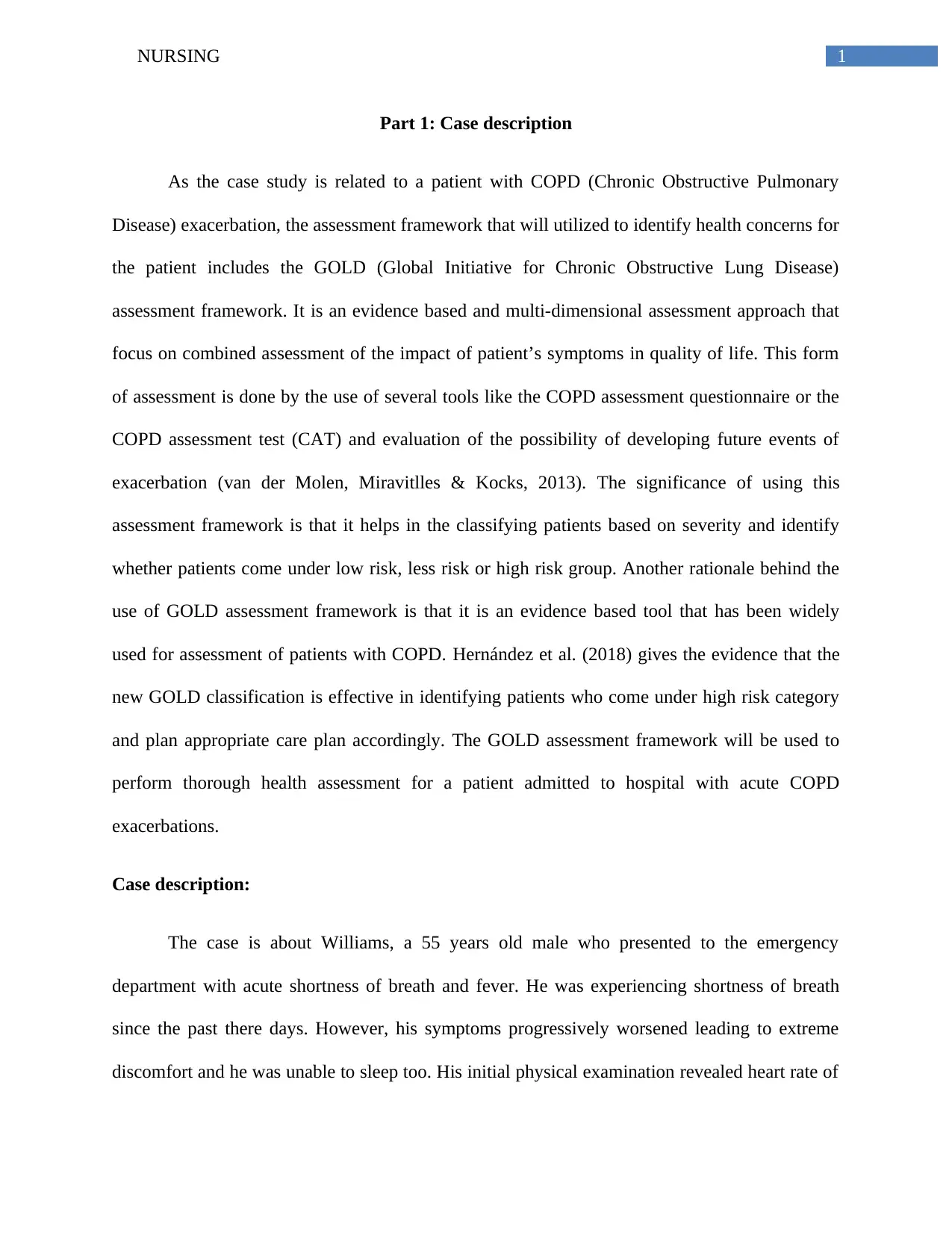
1NURSING
Part 1: Case description
As the case study is related to a patient with COPD (Chronic Obstructive Pulmonary
Disease) exacerbation, the assessment framework that will utilized to identify health concerns for
the patient includes the GOLD (Global Initiative for Chronic Obstructive Lung Disease)
assessment framework. It is an evidence based and multi-dimensional assessment approach that
focus on combined assessment of the impact of patient’s symptoms in quality of life. This form
of assessment is done by the use of several tools like the COPD assessment questionnaire or the
COPD assessment test (CAT) and evaluation of the possibility of developing future events of
exacerbation (van der Molen, Miravitlles & Kocks, 2013). The significance of using this
assessment framework is that it helps in the classifying patients based on severity and identify
whether patients come under low risk, less risk or high risk group. Another rationale behind the
use of GOLD assessment framework is that it is an evidence based tool that has been widely
used for assessment of patients with COPD. Hernández et al. (2018) gives the evidence that the
new GOLD classification is effective in identifying patients who come under high risk category
and plan appropriate care plan accordingly. The GOLD assessment framework will be used to
perform thorough health assessment for a patient admitted to hospital with acute COPD
exacerbations.
Case description:
The case is about Williams, a 55 years old male who presented to the emergency
department with acute shortness of breath and fever. He was experiencing shortness of breath
since the past there days. However, his symptoms progressively worsened leading to extreme
discomfort and he was unable to sleep too. His initial physical examination revealed heart rate of
Part 1: Case description
As the case study is related to a patient with COPD (Chronic Obstructive Pulmonary
Disease) exacerbation, the assessment framework that will utilized to identify health concerns for
the patient includes the GOLD (Global Initiative for Chronic Obstructive Lung Disease)
assessment framework. It is an evidence based and multi-dimensional assessment approach that
focus on combined assessment of the impact of patient’s symptoms in quality of life. This form
of assessment is done by the use of several tools like the COPD assessment questionnaire or the
COPD assessment test (CAT) and evaluation of the possibility of developing future events of
exacerbation (van der Molen, Miravitlles & Kocks, 2013). The significance of using this
assessment framework is that it helps in the classifying patients based on severity and identify
whether patients come under low risk, less risk or high risk group. Another rationale behind the
use of GOLD assessment framework is that it is an evidence based tool that has been widely
used for assessment of patients with COPD. Hernández et al. (2018) gives the evidence that the
new GOLD classification is effective in identifying patients who come under high risk category
and plan appropriate care plan accordingly. The GOLD assessment framework will be used to
perform thorough health assessment for a patient admitted to hospital with acute COPD
exacerbations.
Case description:
The case is about Williams, a 55 years old male who presented to the emergency
department with acute shortness of breath and fever. He was experiencing shortness of breath
since the past there days. However, his symptoms progressively worsened leading to extreme
discomfort and he was unable to sleep too. His initial physical examination revealed heart rate of
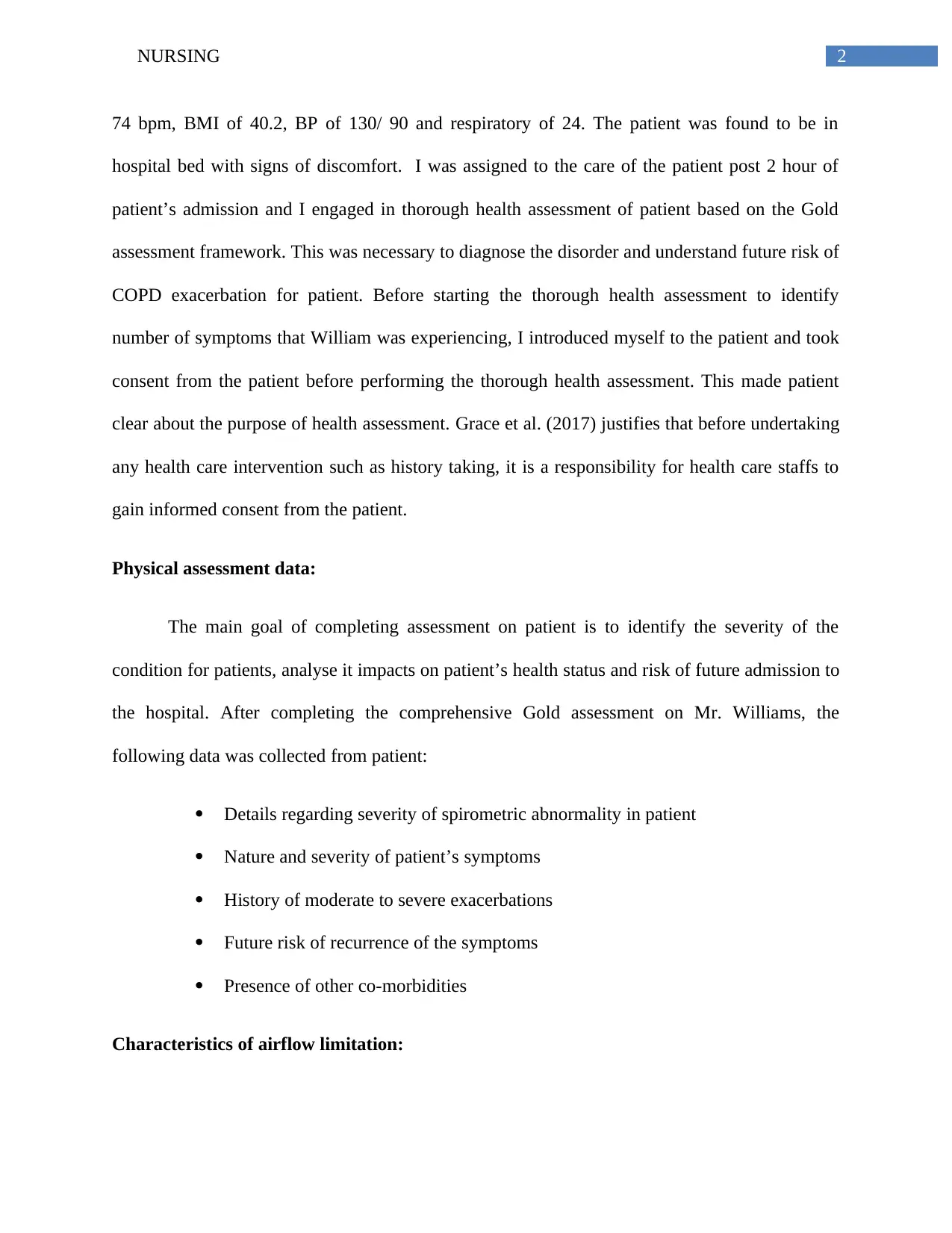
2NURSING
74 bpm, BMI of 40.2, BP of 130/ 90 and respiratory of 24. The patient was found to be in
hospital bed with signs of discomfort. I was assigned to the care of the patient post 2 hour of
patient’s admission and I engaged in thorough health assessment of patient based on the Gold
assessment framework. This was necessary to diagnose the disorder and understand future risk of
COPD exacerbation for patient. Before starting the thorough health assessment to identify
number of symptoms that William was experiencing, I introduced myself to the patient and took
consent from the patient before performing the thorough health assessment. This made patient
clear about the purpose of health assessment. Grace et al. (2017) justifies that before undertaking
any health care intervention such as history taking, it is a responsibility for health care staffs to
gain informed consent from the patient.
Physical assessment data:
The main goal of completing assessment on patient is to identify the severity of the
condition for patients, analyse it impacts on patient’s health status and risk of future admission to
the hospital. After completing the comprehensive Gold assessment on Mr. Williams, the
following data was collected from patient:
Details regarding severity of spirometric abnormality in patient
Nature and severity of patient’s symptoms
History of moderate to severe exacerbations
Future risk of recurrence of the symptoms
Presence of other co-morbidities
Characteristics of airflow limitation:
74 bpm, BMI of 40.2, BP of 130/ 90 and respiratory of 24. The patient was found to be in
hospital bed with signs of discomfort. I was assigned to the care of the patient post 2 hour of
patient’s admission and I engaged in thorough health assessment of patient based on the Gold
assessment framework. This was necessary to diagnose the disorder and understand future risk of
COPD exacerbation for patient. Before starting the thorough health assessment to identify
number of symptoms that William was experiencing, I introduced myself to the patient and took
consent from the patient before performing the thorough health assessment. This made patient
clear about the purpose of health assessment. Grace et al. (2017) justifies that before undertaking
any health care intervention such as history taking, it is a responsibility for health care staffs to
gain informed consent from the patient.
Physical assessment data:
The main goal of completing assessment on patient is to identify the severity of the
condition for patients, analyse it impacts on patient’s health status and risk of future admission to
the hospital. After completing the comprehensive Gold assessment on Mr. Williams, the
following data was collected from patient:
Details regarding severity of spirometric abnormality in patient
Nature and severity of patient’s symptoms
History of moderate to severe exacerbations
Future risk of recurrence of the symptoms
Presence of other co-morbidities
Characteristics of airflow limitation:
⊘ This is a preview!⊘
Do you want full access?
Subscribe today to unlock all pages.

Trusted by 1+ million students worldwide
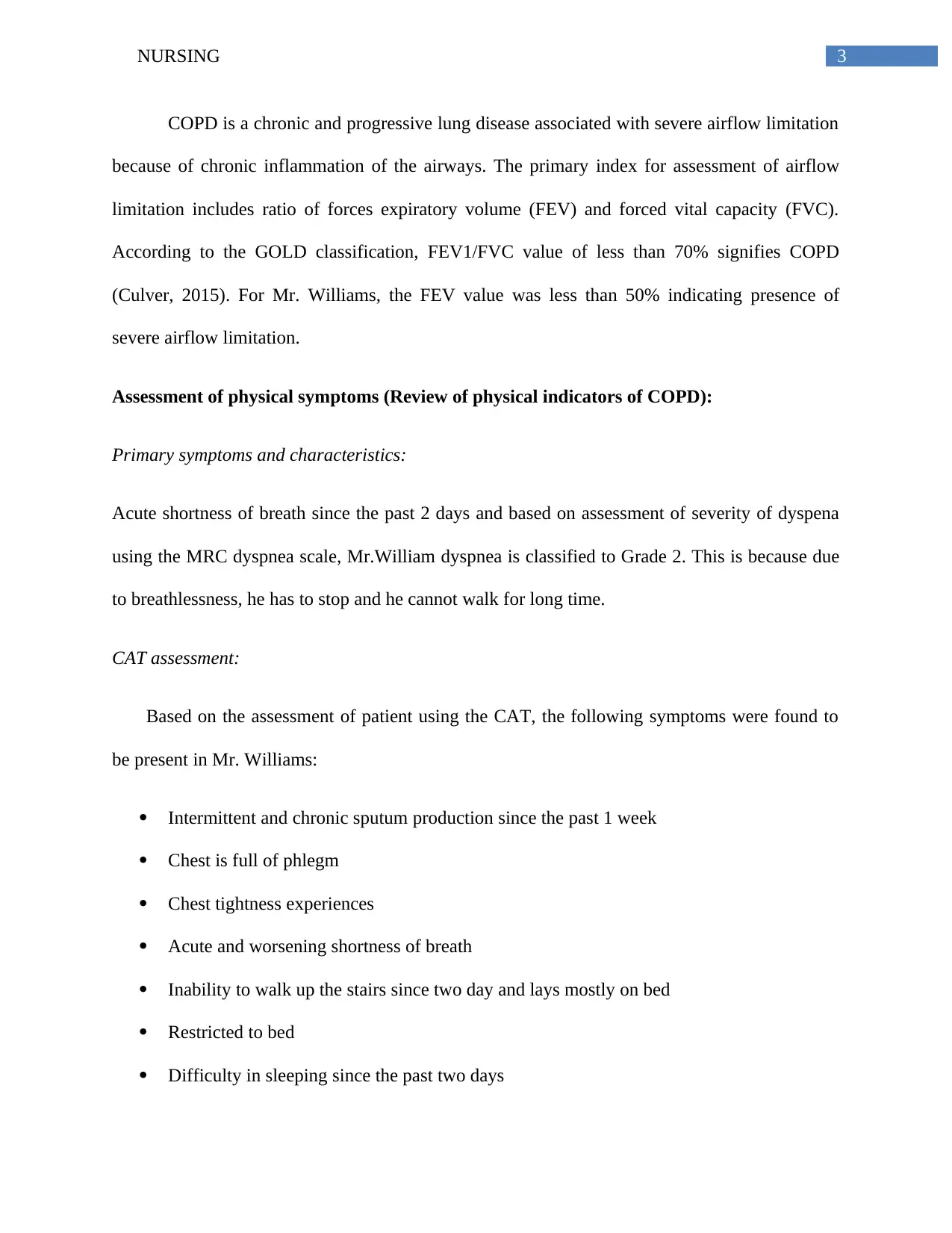
3NURSING
COPD is a chronic and progressive lung disease associated with severe airflow limitation
because of chronic inflammation of the airways. The primary index for assessment of airflow
limitation includes ratio of forces expiratory volume (FEV) and forced vital capacity (FVC).
According to the GOLD classification, FEV1/FVC value of less than 70% signifies COPD
(Culver, 2015). For Mr. Williams, the FEV value was less than 50% indicating presence of
severe airflow limitation.
Assessment of physical symptoms (Review of physical indicators of COPD):
Primary symptoms and characteristics:
Acute shortness of breath since the past 2 days and based on assessment of severity of dyspena
using the MRC dyspnea scale, Mr.William dyspnea is classified to Grade 2. This is because due
to breathlessness, he has to stop and he cannot walk for long time.
CAT assessment:
Based on the assessment of patient using the CAT, the following symptoms were found to
be present in Mr. Williams:
Intermittent and chronic sputum production since the past 1 week
Chest is full of phlegm
Chest tightness experiences
Acute and worsening shortness of breath
Inability to walk up the stairs since two day and lays mostly on bed
Restricted to bed
Difficulty in sleeping since the past two days
COPD is a chronic and progressive lung disease associated with severe airflow limitation
because of chronic inflammation of the airways. The primary index for assessment of airflow
limitation includes ratio of forces expiratory volume (FEV) and forced vital capacity (FVC).
According to the GOLD classification, FEV1/FVC value of less than 70% signifies COPD
(Culver, 2015). For Mr. Williams, the FEV value was less than 50% indicating presence of
severe airflow limitation.
Assessment of physical symptoms (Review of physical indicators of COPD):
Primary symptoms and characteristics:
Acute shortness of breath since the past 2 days and based on assessment of severity of dyspena
using the MRC dyspnea scale, Mr.William dyspnea is classified to Grade 2. This is because due
to breathlessness, he has to stop and he cannot walk for long time.
CAT assessment:
Based on the assessment of patient using the CAT, the following symptoms were found to
be present in Mr. Williams:
Intermittent and chronic sputum production since the past 1 week
Chest is full of phlegm
Chest tightness experiences
Acute and worsening shortness of breath
Inability to walk up the stairs since two day and lays mostly on bed
Restricted to bed
Difficulty in sleeping since the past two days
Paraphrase This Document
Need a fresh take? Get an instant paraphrase of this document with our AI Paraphraser
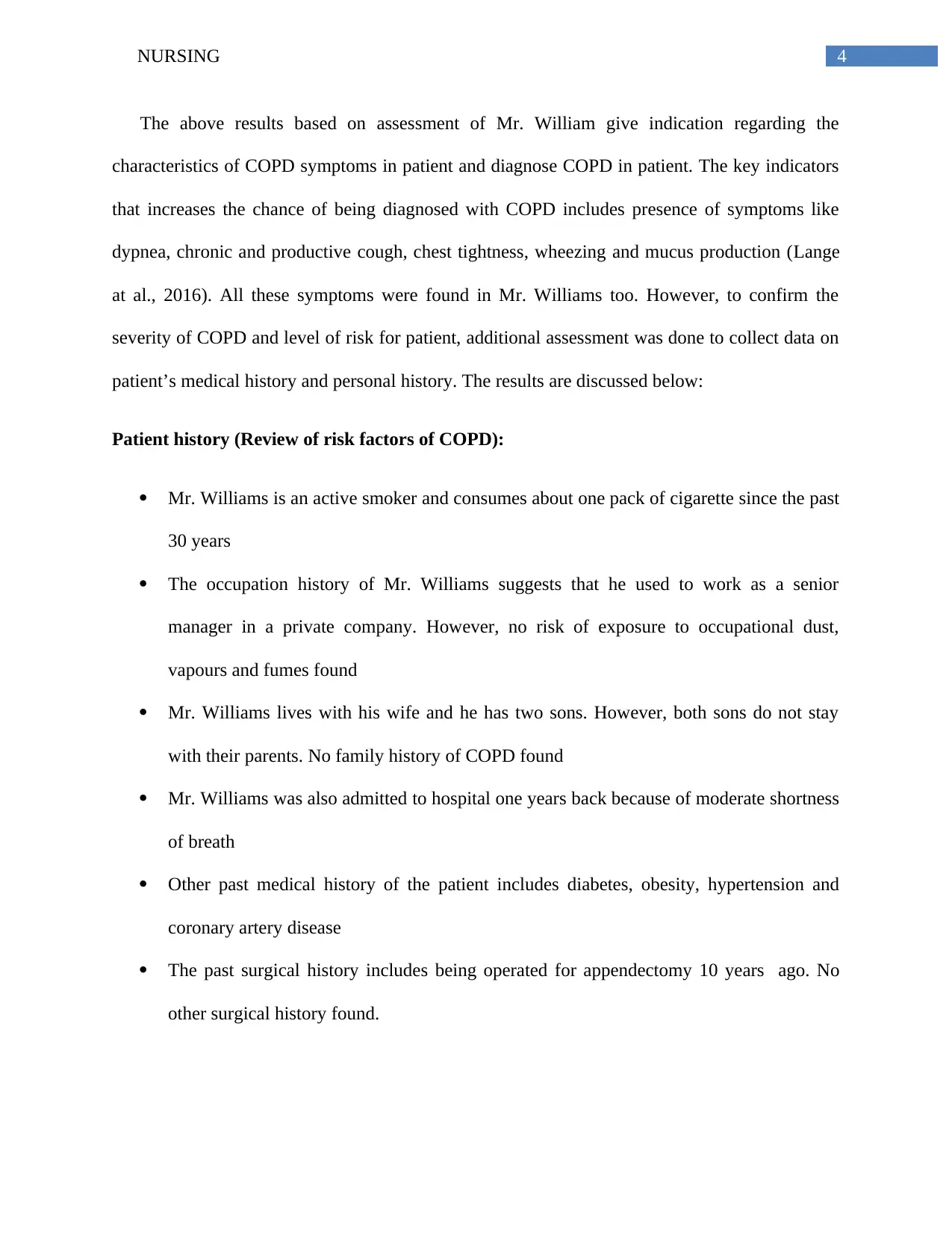
4NURSING
The above results based on assessment of Mr. William give indication regarding the
characteristics of COPD symptoms in patient and diagnose COPD in patient. The key indicators
that increases the chance of being diagnosed with COPD includes presence of symptoms like
dypnea, chronic and productive cough, chest tightness, wheezing and mucus production (Lange
at al., 2016). All these symptoms were found in Mr. Williams too. However, to confirm the
severity of COPD and level of risk for patient, additional assessment was done to collect data on
patient’s medical history and personal history. The results are discussed below:
Patient history (Review of risk factors of COPD):
Mr. Williams is an active smoker and consumes about one pack of cigarette since the past
30 years
The occupation history of Mr. Williams suggests that he used to work as a senior
manager in a private company. However, no risk of exposure to occupational dust,
vapours and fumes found
Mr. Williams lives with his wife and he has two sons. However, both sons do not stay
with their parents. No family history of COPD found
Mr. Williams was also admitted to hospital one years back because of moderate shortness
of breath
Other past medical history of the patient includes diabetes, obesity, hypertension and
coronary artery disease
The past surgical history includes being operated for appendectomy 10 years ago. No
other surgical history found.
The above results based on assessment of Mr. William give indication regarding the
characteristics of COPD symptoms in patient and diagnose COPD in patient. The key indicators
that increases the chance of being diagnosed with COPD includes presence of symptoms like
dypnea, chronic and productive cough, chest tightness, wheezing and mucus production (Lange
at al., 2016). All these symptoms were found in Mr. Williams too. However, to confirm the
severity of COPD and level of risk for patient, additional assessment was done to collect data on
patient’s medical history and personal history. The results are discussed below:
Patient history (Review of risk factors of COPD):
Mr. Williams is an active smoker and consumes about one pack of cigarette since the past
30 years
The occupation history of Mr. Williams suggests that he used to work as a senior
manager in a private company. However, no risk of exposure to occupational dust,
vapours and fumes found
Mr. Williams lives with his wife and he has two sons. However, both sons do not stay
with their parents. No family history of COPD found
Mr. Williams was also admitted to hospital one years back because of moderate shortness
of breath
Other past medical history of the patient includes diabetes, obesity, hypertension and
coronary artery disease
The past surgical history includes being operated for appendectomy 10 years ago. No
other surgical history found.
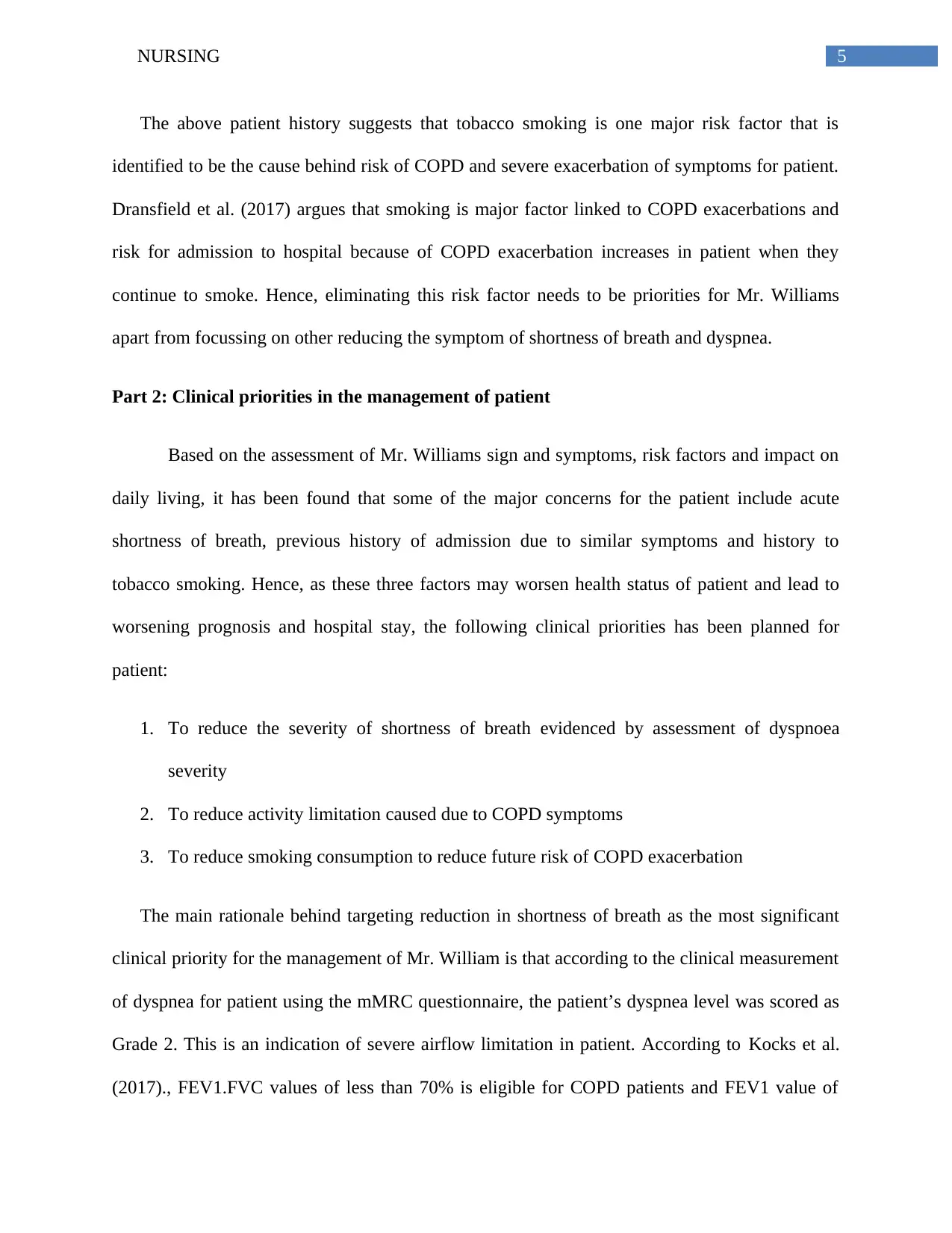
5NURSING
The above patient history suggests that tobacco smoking is one major risk factor that is
identified to be the cause behind risk of COPD and severe exacerbation of symptoms for patient.
Dransfield et al. (2017) argues that smoking is major factor linked to COPD exacerbations and
risk for admission to hospital because of COPD exacerbation increases in patient when they
continue to smoke. Hence, eliminating this risk factor needs to be priorities for Mr. Williams
apart from focussing on other reducing the symptom of shortness of breath and dyspnea.
Part 2: Clinical priorities in the management of patient
Based on the assessment of Mr. Williams sign and symptoms, risk factors and impact on
daily living, it has been found that some of the major concerns for the patient include acute
shortness of breath, previous history of admission due to similar symptoms and history to
tobacco smoking. Hence, as these three factors may worsen health status of patient and lead to
worsening prognosis and hospital stay, the following clinical priorities has been planned for
patient:
1. To reduce the severity of shortness of breath evidenced by assessment of dyspnoea
severity
2. To reduce activity limitation caused due to COPD symptoms
3. To reduce smoking consumption to reduce future risk of COPD exacerbation
The main rationale behind targeting reduction in shortness of breath as the most significant
clinical priority for the management of Mr. William is that according to the clinical measurement
of dyspnea for patient using the mMRC questionnaire, the patient’s dyspnea level was scored as
Grade 2. This is an indication of severe airflow limitation in patient. According to Kocks et al.
(2017)., FEV1.FVC values of less than 70% is eligible for COPD patients and FEV1 value of
The above patient history suggests that tobacco smoking is one major risk factor that is
identified to be the cause behind risk of COPD and severe exacerbation of symptoms for patient.
Dransfield et al. (2017) argues that smoking is major factor linked to COPD exacerbations and
risk for admission to hospital because of COPD exacerbation increases in patient when they
continue to smoke. Hence, eliminating this risk factor needs to be priorities for Mr. Williams
apart from focussing on other reducing the symptom of shortness of breath and dyspnea.
Part 2: Clinical priorities in the management of patient
Based on the assessment of Mr. Williams sign and symptoms, risk factors and impact on
daily living, it has been found that some of the major concerns for the patient include acute
shortness of breath, previous history of admission due to similar symptoms and history to
tobacco smoking. Hence, as these three factors may worsen health status of patient and lead to
worsening prognosis and hospital stay, the following clinical priorities has been planned for
patient:
1. To reduce the severity of shortness of breath evidenced by assessment of dyspnoea
severity
2. To reduce activity limitation caused due to COPD symptoms
3. To reduce smoking consumption to reduce future risk of COPD exacerbation
The main rationale behind targeting reduction in shortness of breath as the most significant
clinical priority for the management of Mr. William is that according to the clinical measurement
of dyspnea for patient using the mMRC questionnaire, the patient’s dyspnea level was scored as
Grade 2. This is an indication of severe airflow limitation in patient. According to Kocks et al.
(2017)., FEV1.FVC values of less than 70% is eligible for COPD patients and FEV1 value of
⊘ This is a preview!⊘
Do you want full access?
Subscribe today to unlock all pages.

Trusted by 1+ million students worldwide
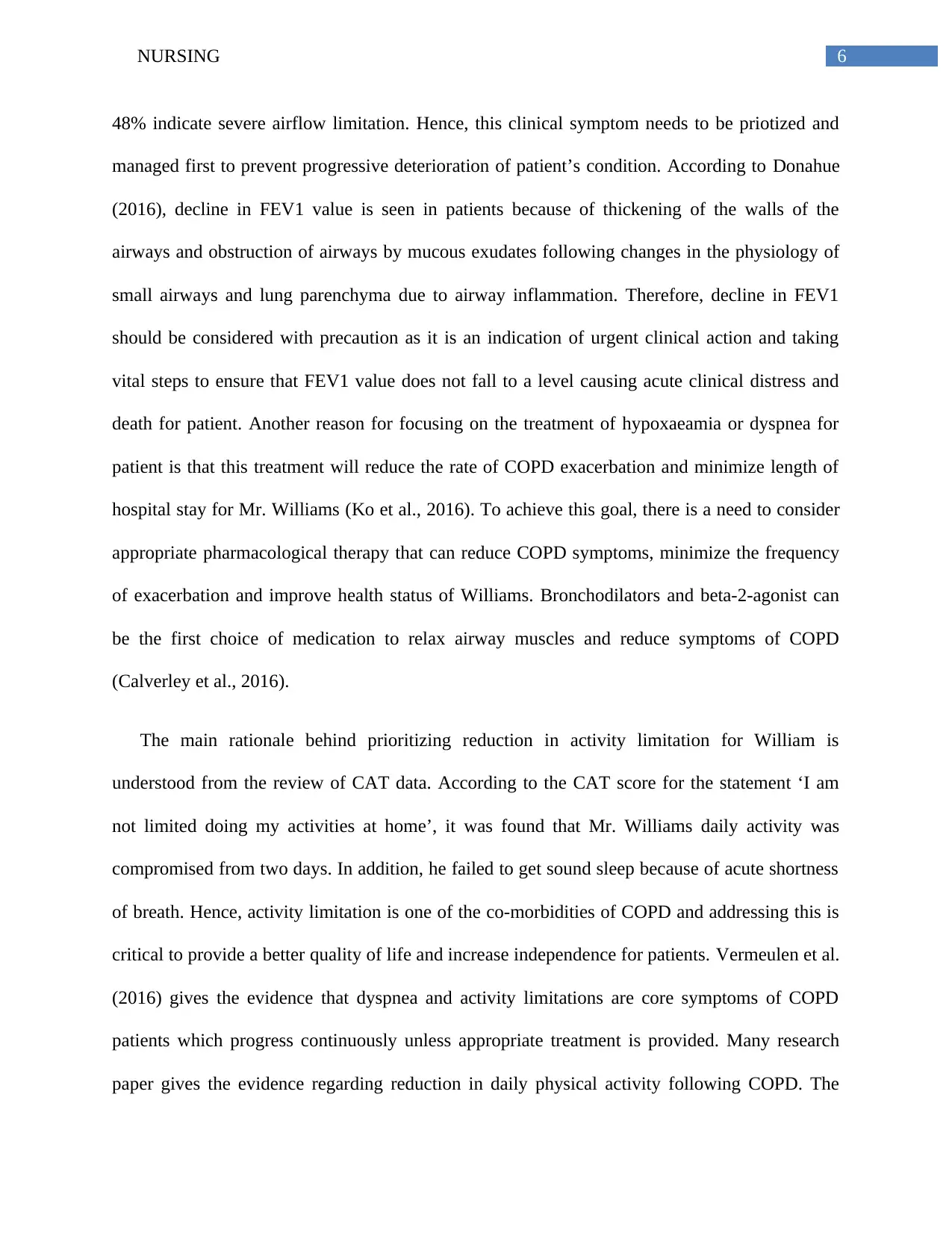
6NURSING
48% indicate severe airflow limitation. Hence, this clinical symptom needs to be priotized and
managed first to prevent progressive deterioration of patient’s condition. According to Donahue
(2016), decline in FEV1 value is seen in patients because of thickening of the walls of the
airways and obstruction of airways by mucous exudates following changes in the physiology of
small airways and lung parenchyma due to airway inflammation. Therefore, decline in FEV1
should be considered with precaution as it is an indication of urgent clinical action and taking
vital steps to ensure that FEV1 value does not fall to a level causing acute clinical distress and
death for patient. Another reason for focusing on the treatment of hypoxaeamia or dyspnea for
patient is that this treatment will reduce the rate of COPD exacerbation and minimize length of
hospital stay for Mr. Williams (Ko et al., 2016). To achieve this goal, there is a need to consider
appropriate pharmacological therapy that can reduce COPD symptoms, minimize the frequency
of exacerbation and improve health status of Williams. Bronchodilators and beta-2-agonist can
be the first choice of medication to relax airway muscles and reduce symptoms of COPD
(Calverley et al., 2016).
The main rationale behind prioritizing reduction in activity limitation for William is
understood from the review of CAT data. According to the CAT score for the statement ‘I am
not limited doing my activities at home’, it was found that Mr. Williams daily activity was
compromised from two days. In addition, he failed to get sound sleep because of acute shortness
of breath. Hence, activity limitation is one of the co-morbidities of COPD and addressing this is
critical to provide a better quality of life and increase independence for patients. Vermeulen et al.
(2016) gives the evidence that dyspnea and activity limitations are core symptoms of COPD
patients which progress continuously unless appropriate treatment is provided. Many research
paper gives the evidence regarding reduction in daily physical activity following COPD. The
48% indicate severe airflow limitation. Hence, this clinical symptom needs to be priotized and
managed first to prevent progressive deterioration of patient’s condition. According to Donahue
(2016), decline in FEV1 value is seen in patients because of thickening of the walls of the
airways and obstruction of airways by mucous exudates following changes in the physiology of
small airways and lung parenchyma due to airway inflammation. Therefore, decline in FEV1
should be considered with precaution as it is an indication of urgent clinical action and taking
vital steps to ensure that FEV1 value does not fall to a level causing acute clinical distress and
death for patient. Another reason for focusing on the treatment of hypoxaeamia or dyspnea for
patient is that this treatment will reduce the rate of COPD exacerbation and minimize length of
hospital stay for Mr. Williams (Ko et al., 2016). To achieve this goal, there is a need to consider
appropriate pharmacological therapy that can reduce COPD symptoms, minimize the frequency
of exacerbation and improve health status of Williams. Bronchodilators and beta-2-agonist can
be the first choice of medication to relax airway muscles and reduce symptoms of COPD
(Calverley et al., 2016).
The main rationale behind prioritizing reduction in activity limitation for William is
understood from the review of CAT data. According to the CAT score for the statement ‘I am
not limited doing my activities at home’, it was found that Mr. Williams daily activity was
compromised from two days. In addition, he failed to get sound sleep because of acute shortness
of breath. Hence, activity limitation is one of the co-morbidities of COPD and addressing this is
critical to provide a better quality of life and increase independence for patients. Vermeulen et al.
(2016) gives the evidence that dyspnea and activity limitations are core symptoms of COPD
patients which progress continuously unless appropriate treatment is provided. Many research
paper gives the evidence regarding reduction in daily physical activity following COPD. The
Paraphrase This Document
Need a fresh take? Get an instant paraphrase of this document with our AI Paraphraser
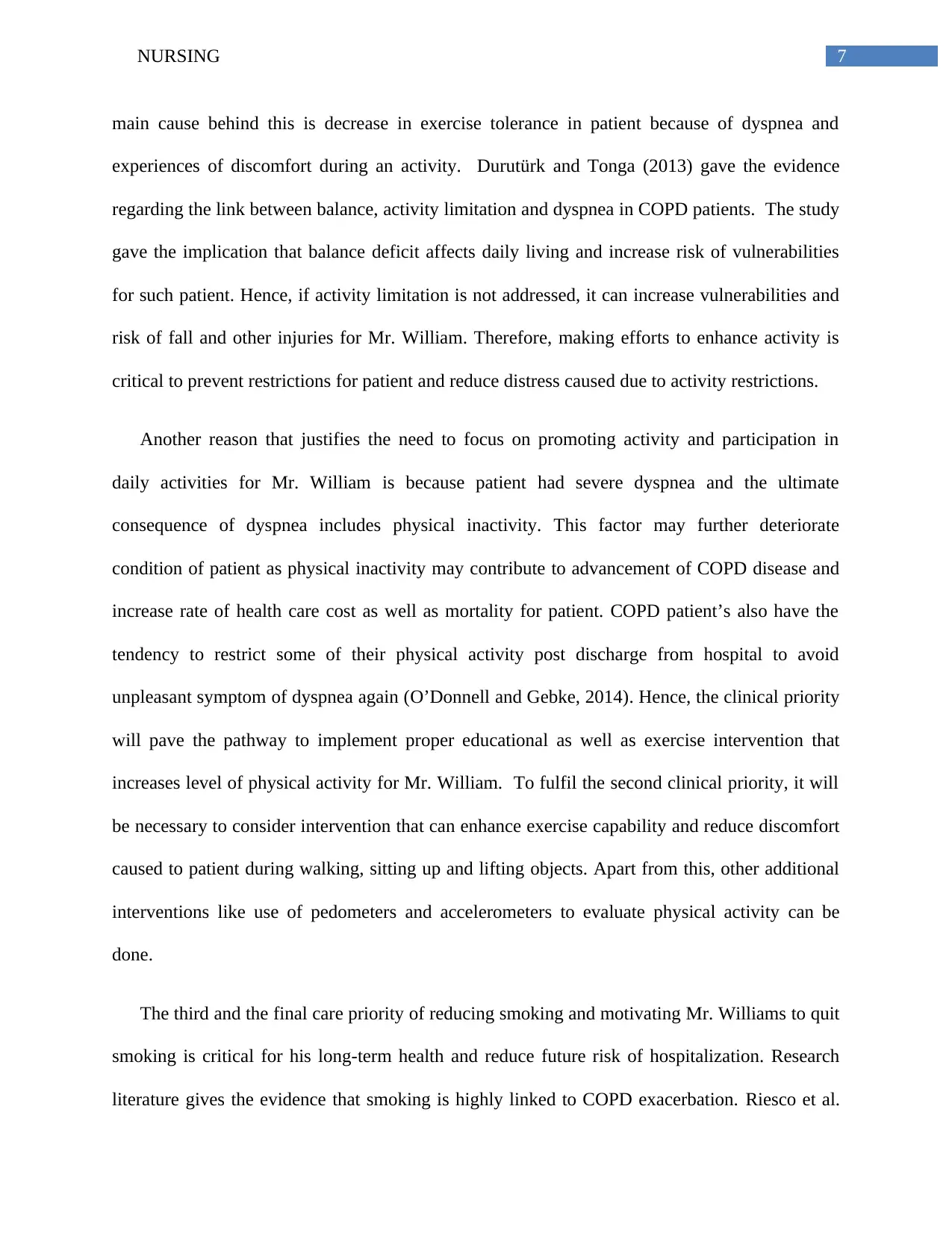
7NURSING
main cause behind this is decrease in exercise tolerance in patient because of dyspnea and
experiences of discomfort during an activity. Durutürk and Tonga (2013) gave the evidence
regarding the link between balance, activity limitation and dyspnea in COPD patients. The study
gave the implication that balance deficit affects daily living and increase risk of vulnerabilities
for such patient. Hence, if activity limitation is not addressed, it can increase vulnerabilities and
risk of fall and other injuries for Mr. William. Therefore, making efforts to enhance activity is
critical to prevent restrictions for patient and reduce distress caused due to activity restrictions.
Another reason that justifies the need to focus on promoting activity and participation in
daily activities for Mr. William is because patient had severe dyspnea and the ultimate
consequence of dyspnea includes physical inactivity. This factor may further deteriorate
condition of patient as physical inactivity may contribute to advancement of COPD disease and
increase rate of health care cost as well as mortality for patient. COPD patient’s also have the
tendency to restrict some of their physical activity post discharge from hospital to avoid
unpleasant symptom of dyspnea again (O’Donnell and Gebke, 2014). Hence, the clinical priority
will pave the pathway to implement proper educational as well as exercise intervention that
increases level of physical activity for Mr. William. To fulfil the second clinical priority, it will
be necessary to consider intervention that can enhance exercise capability and reduce discomfort
caused to patient during walking, sitting up and lifting objects. Apart from this, other additional
interventions like use of pedometers and accelerometers to evaluate physical activity can be
done.
The third and the final care priority of reducing smoking and motivating Mr. Williams to quit
smoking is critical for his long-term health and reduce future risk of hospitalization. Research
literature gives the evidence that smoking is highly linked to COPD exacerbation. Riesco et al.
main cause behind this is decrease in exercise tolerance in patient because of dyspnea and
experiences of discomfort during an activity. Durutürk and Tonga (2013) gave the evidence
regarding the link between balance, activity limitation and dyspnea in COPD patients. The study
gave the implication that balance deficit affects daily living and increase risk of vulnerabilities
for such patient. Hence, if activity limitation is not addressed, it can increase vulnerabilities and
risk of fall and other injuries for Mr. William. Therefore, making efforts to enhance activity is
critical to prevent restrictions for patient and reduce distress caused due to activity restrictions.
Another reason that justifies the need to focus on promoting activity and participation in
daily activities for Mr. William is because patient had severe dyspnea and the ultimate
consequence of dyspnea includes physical inactivity. This factor may further deteriorate
condition of patient as physical inactivity may contribute to advancement of COPD disease and
increase rate of health care cost as well as mortality for patient. COPD patient’s also have the
tendency to restrict some of their physical activity post discharge from hospital to avoid
unpleasant symptom of dyspnea again (O’Donnell and Gebke, 2014). Hence, the clinical priority
will pave the pathway to implement proper educational as well as exercise intervention that
increases level of physical activity for Mr. William. To fulfil the second clinical priority, it will
be necessary to consider intervention that can enhance exercise capability and reduce discomfort
caused to patient during walking, sitting up and lifting objects. Apart from this, other additional
interventions like use of pedometers and accelerometers to evaluate physical activity can be
done.
The third and the final care priority of reducing smoking and motivating Mr. Williams to quit
smoking is critical for his long-term health and reduce future risk of hospitalization. Research
literature gives the evidence that smoking is highly linked to COPD exacerbation. Riesco et al.
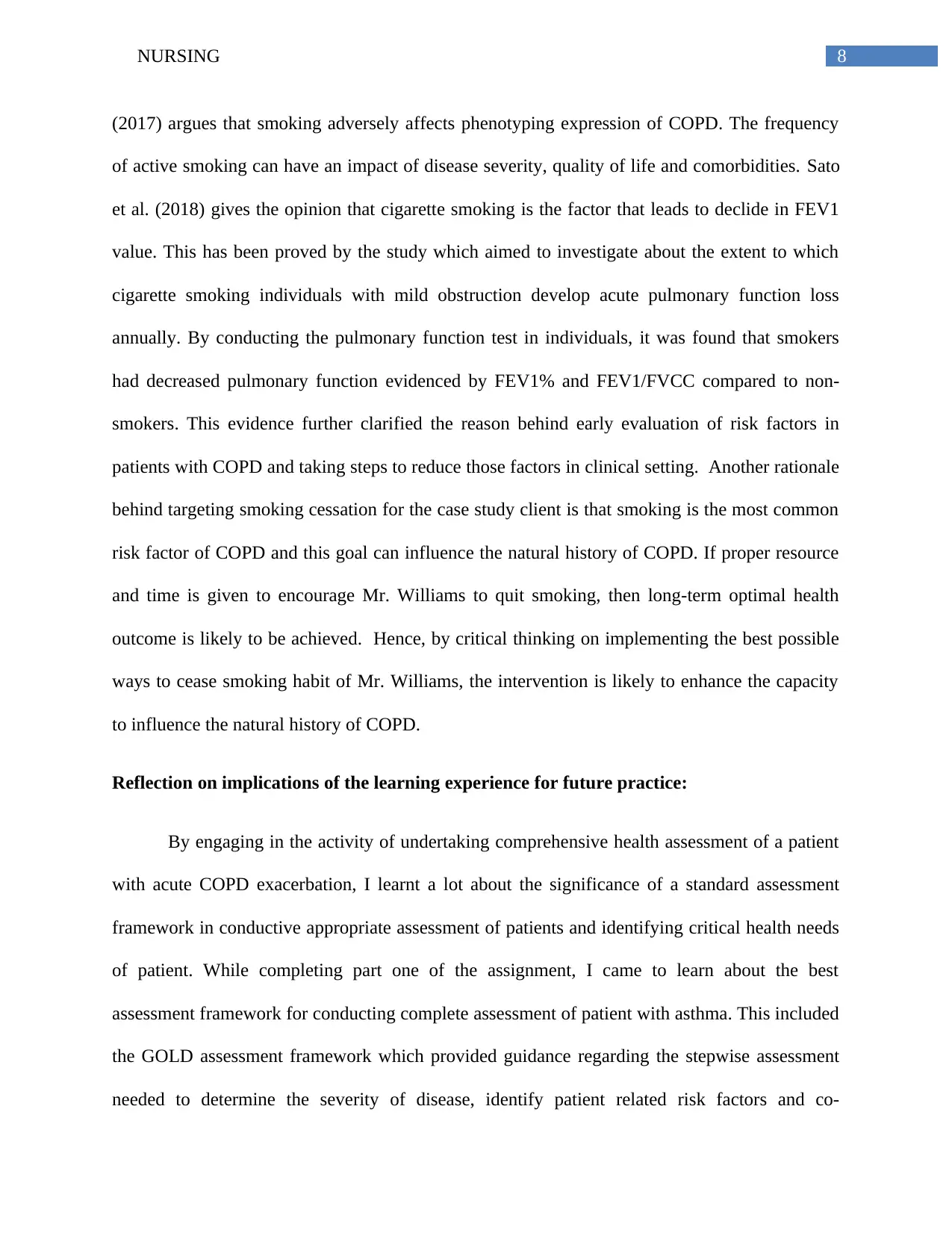
8NURSING
(2017) argues that smoking adversely affects phenotyping expression of COPD. The frequency
of active smoking can have an impact of disease severity, quality of life and comorbidities. Sato
et al. (2018) gives the opinion that cigarette smoking is the factor that leads to declide in FEV1
value. This has been proved by the study which aimed to investigate about the extent to which
cigarette smoking individuals with mild obstruction develop acute pulmonary function loss
annually. By conducting the pulmonary function test in individuals, it was found that smokers
had decreased pulmonary function evidenced by FEV1% and FEV1/FVCC compared to non-
smokers. This evidence further clarified the reason behind early evaluation of risk factors in
patients with COPD and taking steps to reduce those factors in clinical setting. Another rationale
behind targeting smoking cessation for the case study client is that smoking is the most common
risk factor of COPD and this goal can influence the natural history of COPD. If proper resource
and time is given to encourage Mr. Williams to quit smoking, then long-term optimal health
outcome is likely to be achieved. Hence, by critical thinking on implementing the best possible
ways to cease smoking habit of Mr. Williams, the intervention is likely to enhance the capacity
to influence the natural history of COPD.
Reflection on implications of the learning experience for future practice:
By engaging in the activity of undertaking comprehensive health assessment of a patient
with acute COPD exacerbation, I learnt a lot about the significance of a standard assessment
framework in conductive appropriate assessment of patients and identifying critical health needs
of patient. While completing part one of the assignment, I came to learn about the best
assessment framework for conducting complete assessment of patient with asthma. This included
the GOLD assessment framework which provided guidance regarding the stepwise assessment
needed to determine the severity of disease, identify patient related risk factors and co-
(2017) argues that smoking adversely affects phenotyping expression of COPD. The frequency
of active smoking can have an impact of disease severity, quality of life and comorbidities. Sato
et al. (2018) gives the opinion that cigarette smoking is the factor that leads to declide in FEV1
value. This has been proved by the study which aimed to investigate about the extent to which
cigarette smoking individuals with mild obstruction develop acute pulmonary function loss
annually. By conducting the pulmonary function test in individuals, it was found that smokers
had decreased pulmonary function evidenced by FEV1% and FEV1/FVCC compared to non-
smokers. This evidence further clarified the reason behind early evaluation of risk factors in
patients with COPD and taking steps to reduce those factors in clinical setting. Another rationale
behind targeting smoking cessation for the case study client is that smoking is the most common
risk factor of COPD and this goal can influence the natural history of COPD. If proper resource
and time is given to encourage Mr. Williams to quit smoking, then long-term optimal health
outcome is likely to be achieved. Hence, by critical thinking on implementing the best possible
ways to cease smoking habit of Mr. Williams, the intervention is likely to enhance the capacity
to influence the natural history of COPD.
Reflection on implications of the learning experience for future practice:
By engaging in the activity of undertaking comprehensive health assessment of a patient
with acute COPD exacerbation, I learnt a lot about the significance of a standard assessment
framework in conductive appropriate assessment of patients and identifying critical health needs
of patient. While completing part one of the assignment, I came to learn about the best
assessment framework for conducting complete assessment of patient with asthma. This included
the GOLD assessment framework which provided guidance regarding the stepwise assessment
needed to determine the severity of disease, identify patient related risk factors and co-
⊘ This is a preview!⊘
Do you want full access?
Subscribe today to unlock all pages.

Trusted by 1+ million students worldwide
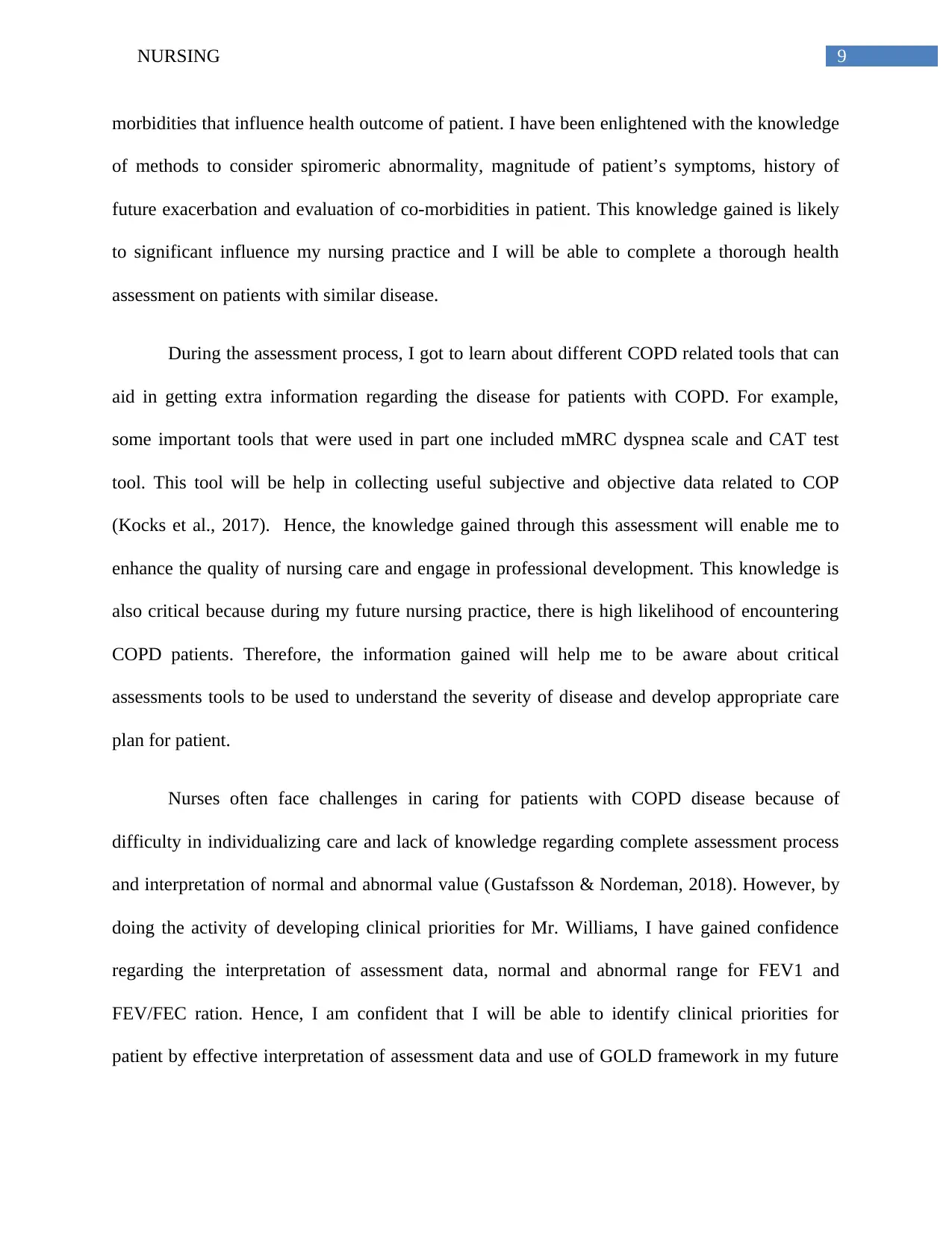
9NURSING
morbidities that influence health outcome of patient. I have been enlightened with the knowledge
of methods to consider spiromeric abnormality, magnitude of patient’s symptoms, history of
future exacerbation and evaluation of co-morbidities in patient. This knowledge gained is likely
to significant influence my nursing practice and I will be able to complete a thorough health
assessment on patients with similar disease.
During the assessment process, I got to learn about different COPD related tools that can
aid in getting extra information regarding the disease for patients with COPD. For example,
some important tools that were used in part one included mMRC dyspnea scale and CAT test
tool. This tool will be help in collecting useful subjective and objective data related to COP
(Kocks et al., 2017). Hence, the knowledge gained through this assessment will enable me to
enhance the quality of nursing care and engage in professional development. This knowledge is
also critical because during my future nursing practice, there is high likelihood of encountering
COPD patients. Therefore, the information gained will help me to be aware about critical
assessments tools to be used to understand the severity of disease and develop appropriate care
plan for patient.
Nurses often face challenges in caring for patients with COPD disease because of
difficulty in individualizing care and lack of knowledge regarding complete assessment process
and interpretation of normal and abnormal value (Gustafsson & Nordeman, 2018). However, by
doing the activity of developing clinical priorities for Mr. Williams, I have gained confidence
regarding the interpretation of assessment data, normal and abnormal range for FEV1 and
FEV/FEC ration. Hence, I am confident that I will be able to identify clinical priorities for
patient by effective interpretation of assessment data and use of GOLD framework in my future
morbidities that influence health outcome of patient. I have been enlightened with the knowledge
of methods to consider spiromeric abnormality, magnitude of patient’s symptoms, history of
future exacerbation and evaluation of co-morbidities in patient. This knowledge gained is likely
to significant influence my nursing practice and I will be able to complete a thorough health
assessment on patients with similar disease.
During the assessment process, I got to learn about different COPD related tools that can
aid in getting extra information regarding the disease for patients with COPD. For example,
some important tools that were used in part one included mMRC dyspnea scale and CAT test
tool. This tool will be help in collecting useful subjective and objective data related to COP
(Kocks et al., 2017). Hence, the knowledge gained through this assessment will enable me to
enhance the quality of nursing care and engage in professional development. This knowledge is
also critical because during my future nursing practice, there is high likelihood of encountering
COPD patients. Therefore, the information gained will help me to be aware about critical
assessments tools to be used to understand the severity of disease and develop appropriate care
plan for patient.
Nurses often face challenges in caring for patients with COPD disease because of
difficulty in individualizing care and lack of knowledge regarding complete assessment process
and interpretation of normal and abnormal value (Gustafsson & Nordeman, 2018). However, by
doing the activity of developing clinical priorities for Mr. Williams, I have gained confidence
regarding the interpretation of assessment data, normal and abnormal range for FEV1 and
FEV/FEC ration. Hence, I am confident that I will be able to identify clinical priorities for
patient by effective interpretation of assessment data and use of GOLD framework in my future
Paraphrase This Document
Need a fresh take? Get an instant paraphrase of this document with our AI Paraphraser

10NURSING
practice. The activity gave me the opportunity for continued learning and developing skills to
complete accurate assessment on patients with COPD exacerbation.
practice. The activity gave me the opportunity for continued learning and developing skills to
complete accurate assessment on patients with COPD exacerbation.
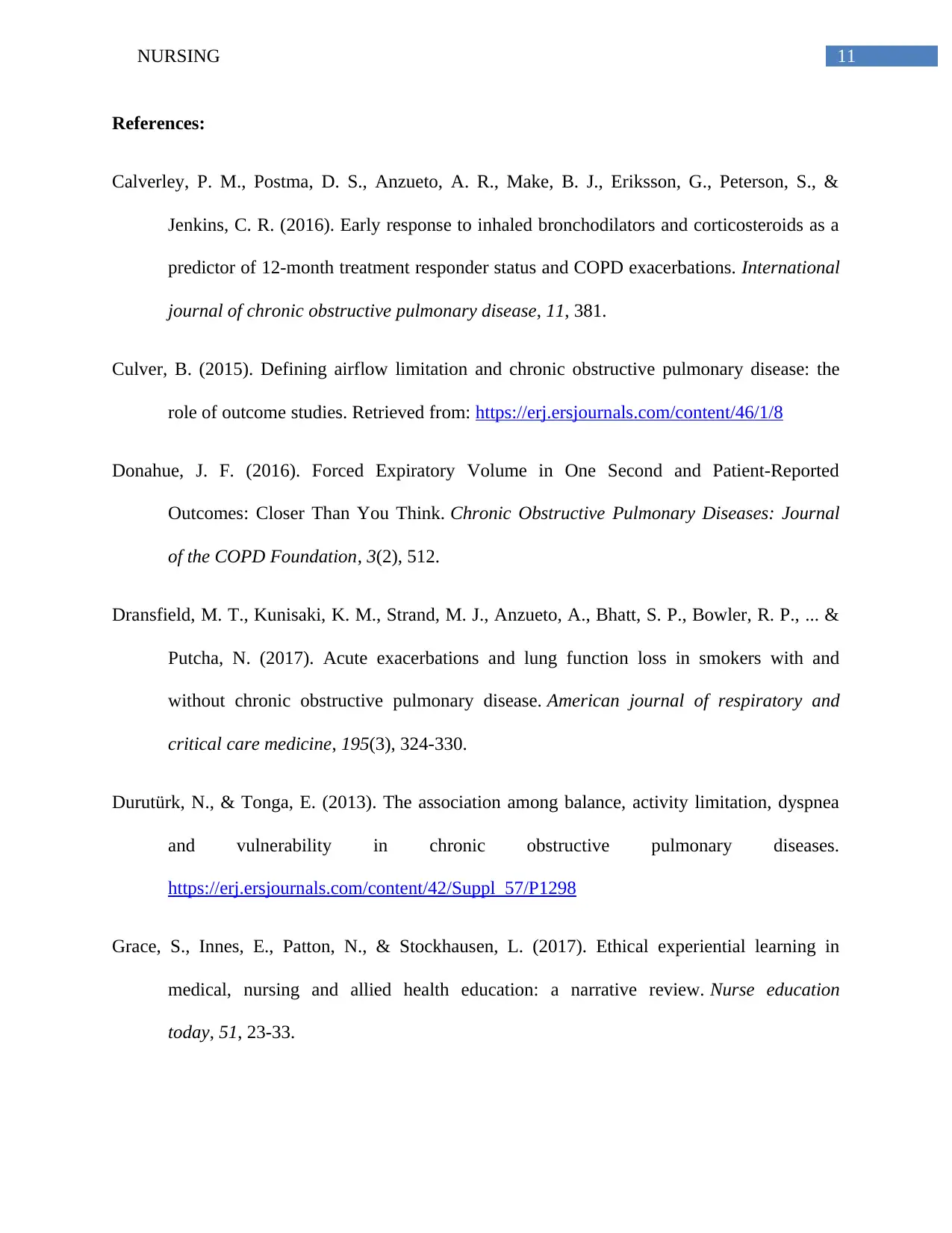
11NURSING
References:
Calverley, P. M., Postma, D. S., Anzueto, A. R., Make, B. J., Eriksson, G., Peterson, S., &
Jenkins, C. R. (2016). Early response to inhaled bronchodilators and corticosteroids as a
predictor of 12-month treatment responder status and COPD exacerbations. International
journal of chronic obstructive pulmonary disease, 11, 381.
Culver, B. (2015). Defining airflow limitation and chronic obstructive pulmonary disease: the
role of outcome studies. Retrieved from: https://erj.ersjournals.com/content/46/1/8
Donahue, J. F. (2016). Forced Expiratory Volume in One Second and Patient-Reported
Outcomes: Closer Than You Think. Chronic Obstructive Pulmonary Diseases: Journal
of the COPD Foundation, 3(2), 512.
Dransfield, M. T., Kunisaki, K. M., Strand, M. J., Anzueto, A., Bhatt, S. P., Bowler, R. P., ... &
Putcha, N. (2017). Acute exacerbations and lung function loss in smokers with and
without chronic obstructive pulmonary disease. American journal of respiratory and
critical care medicine, 195(3), 324-330.
Durutürk, N., & Tonga, E. (2013). The association among balance, activity limitation, dyspnea
and vulnerability in chronic obstructive pulmonary diseases.
https://erj.ersjournals.com/content/42/Suppl_57/P1298
Grace, S., Innes, E., Patton, N., & Stockhausen, L. (2017). Ethical experiential learning in
medical, nursing and allied health education: a narrative review. Nurse education
today, 51, 23-33.
References:
Calverley, P. M., Postma, D. S., Anzueto, A. R., Make, B. J., Eriksson, G., Peterson, S., &
Jenkins, C. R. (2016). Early response to inhaled bronchodilators and corticosteroids as a
predictor of 12-month treatment responder status and COPD exacerbations. International
journal of chronic obstructive pulmonary disease, 11, 381.
Culver, B. (2015). Defining airflow limitation and chronic obstructive pulmonary disease: the
role of outcome studies. Retrieved from: https://erj.ersjournals.com/content/46/1/8
Donahue, J. F. (2016). Forced Expiratory Volume in One Second and Patient-Reported
Outcomes: Closer Than You Think. Chronic Obstructive Pulmonary Diseases: Journal
of the COPD Foundation, 3(2), 512.
Dransfield, M. T., Kunisaki, K. M., Strand, M. J., Anzueto, A., Bhatt, S. P., Bowler, R. P., ... &
Putcha, N. (2017). Acute exacerbations and lung function loss in smokers with and
without chronic obstructive pulmonary disease. American journal of respiratory and
critical care medicine, 195(3), 324-330.
Durutürk, N., & Tonga, E. (2013). The association among balance, activity limitation, dyspnea
and vulnerability in chronic obstructive pulmonary diseases.
https://erj.ersjournals.com/content/42/Suppl_57/P1298
Grace, S., Innes, E., Patton, N., & Stockhausen, L. (2017). Ethical experiential learning in
medical, nursing and allied health education: a narrative review. Nurse education
today, 51, 23-33.
⊘ This is a preview!⊘
Do you want full access?
Subscribe today to unlock all pages.

Trusted by 1+ million students worldwide
1 out of 15
Related Documents
Your All-in-One AI-Powered Toolkit for Academic Success.
+13062052269
info@desklib.com
Available 24*7 on WhatsApp / Email
![[object Object]](/_next/static/media/star-bottom.7253800d.svg)
Unlock your academic potential
Copyright © 2020–2025 A2Z Services. All Rights Reserved. Developed and managed by ZUCOL.





